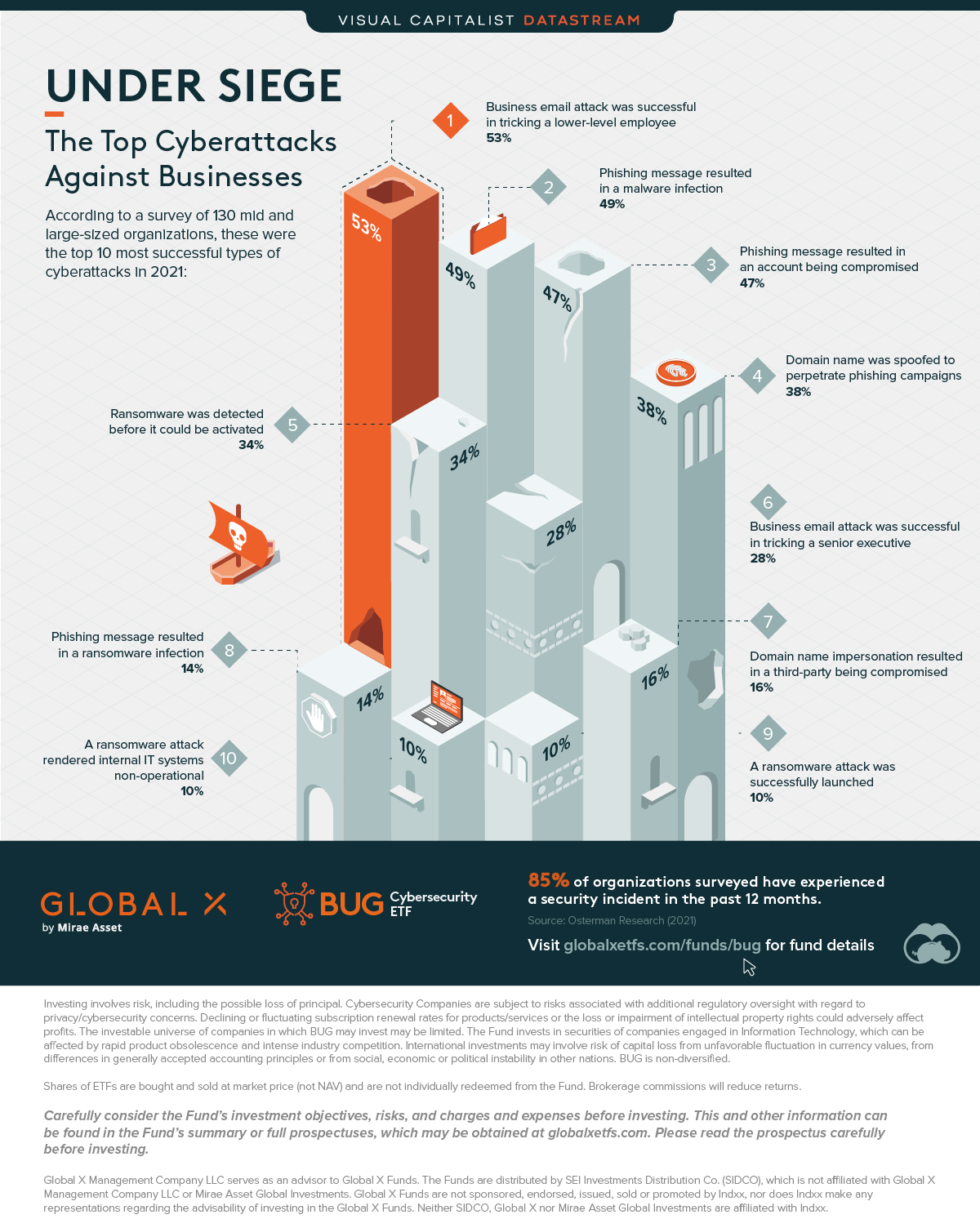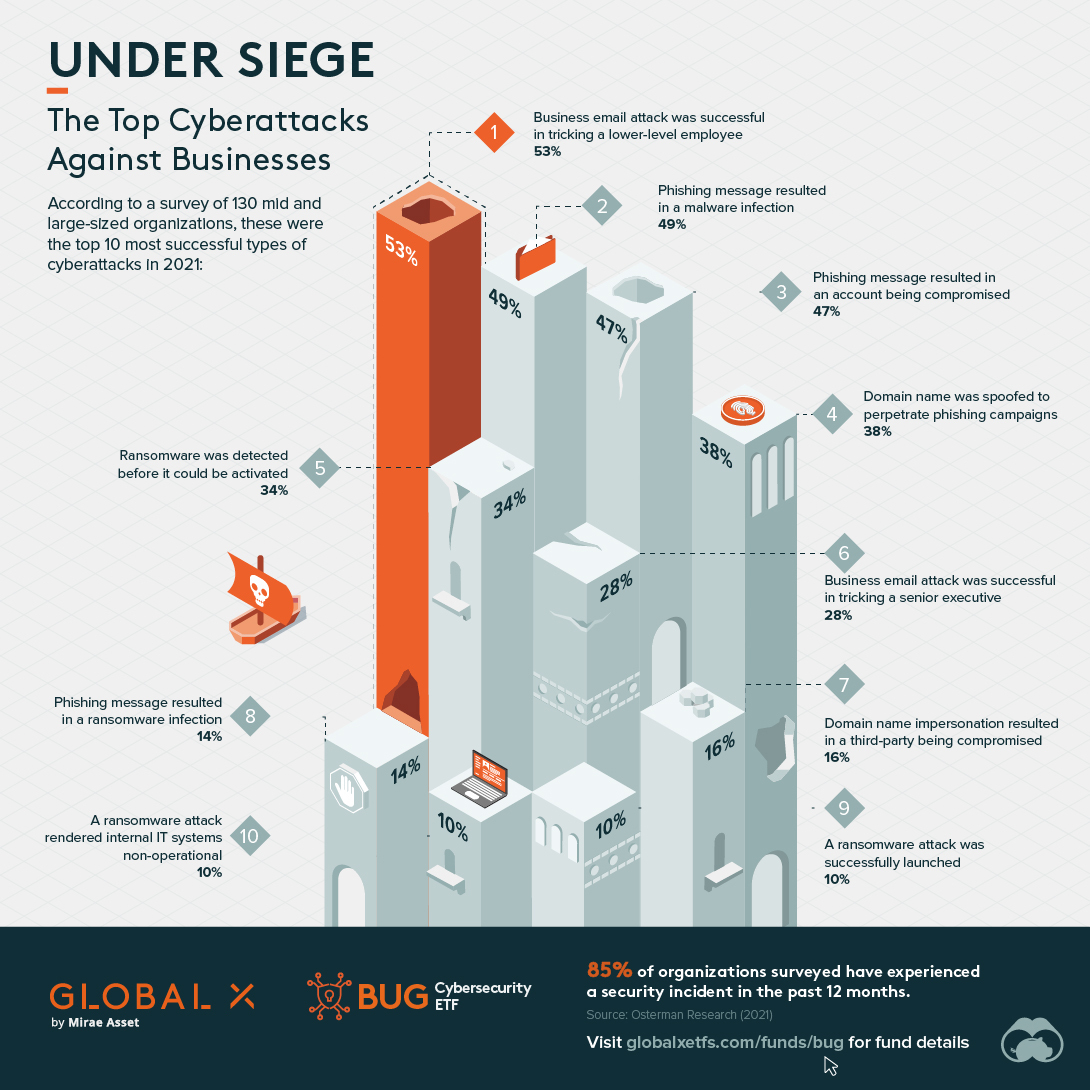Datastream
Ranked: The Top Cyberattacks Against Businesses
The following content is sponsored by Global X ETFs.

Ranked: The Top Cyberattacks Against Businesses
Cyberattacks hit a record high in 2021, continuing the momentum that had developed during the COVID-19 pandemic. One reason for this increase is the shift to remote work, which has opened up new vulnerabilities. Home networks are typically less secure, and the rapid rise in the use of online services means security is falling behind.
In this graphic sponsored by Global X ETFs, we’ve visualized survey results showing the 10 most successful types of cyberattacks in 2021.
The Results
These results are from a 2021 whitepaper by Osterman Research, a market research firm focused on cybersecurity. They surveyed 130 cybersecurity professionals from mid and large-sized organizations to see which types of attacks were the most prominent.
| Type of Attack | Percentage of respondents (%) |
|---|---|
| Business email attack was successful in tricking a lower-level employee | 53% |
| Phishing message resulted in a malware infection | 49% |
| Phishing message resulted in an account being compromised | 47% |
| Domain name was spoofed to perpetrate phishing campaigns | 38% |
| Ransomware was detected before it could be activated | 34% |
| Business email attack was successful in tricking a senior executive | 28% |
| Domain name impersonation resulted in a third-party being compromised | 16% |
| Phishing message resulted in a ransomware infection | 14% |
| A ransomware attack was successfully launched | 10% |
| A ransomware attack rendered internal IT systems non-operational | 10% |
Source: Osterman Research (2021)
The report notes that these figures may be understated because organizations are likely to downplay their security incidents. Organizations may also lack the capability to detect all types of cyberattacks.
The Impact of Phishing Attacks
Phishing refers to an attack where the perpetrator pretends to be a trusted entity. These attacks can be carried out over email, text message (SMS), and even social media apps. The goal is often to trick the victim into opening a malicious link.
According to the whitepaper, opening malicious links can result in credential theft or ransomware infections. Credential theft is when attackers gain access to internal systems. This is incredibly dangerous, as it allows attackers to commit fraud, impersonate company officials, and steal data.
A powerful tool for preventing credential theft is multi-factor authentication (MFA). This method requires users to provide multiple verification factors to access a resource (instead of a single password).
The Threat of Ransomware
Ransomware is a type of cyberattack that involves blackmail, often for financial gain. For ransomware to be successfully planted, attackers must first gain access to a company’s networks.
Access can be gained through phishing, as discussed above, or alternate means such as compromised software updates. One such attack impacted over 57,000 Asus laptop owners in Russia after hackers created a malicious update tool on an official Asus server.
Cybercriminals have become increasingly ruthless in how ransomware attacks are executed.
– Osterman Research
Researchers have warned that ransomware attacks are becoming more dangerous and sophisticated. In addition to locking organizations out from core systems, hackers are also stealing data to increase their leverage. If a ransom is not paid, the stolen data may be published or even sold to the highest bidder.
Under Siege
The rising frequency and sophistication of cybercriminal activity is a major threat to the world.
According to the World Economic Forum’s 2022 Global Risks Report, ransomware attacks have increased by 435% since 2020. Furthermore, there is an estimated shortage of 3 million cybersecurity professionals worldwide.
To catch up, businesses and governments are expected to increase their spending on cybersecurity over the next several years.
The Global X Cybersecurity ETF is a passively managed solution that can be used to gain exposure to the rising adoption of cybersecurity technologies. Click the link to learn more.
UK Only
Charting the Rise of Cross-Border Money Transfers (2015-2023)
With over 280 million immigrants transferring billions of dollars annually, the remittance industry has become more valuable than ever.

The Briefing
- 79% of remittance payments in 2022 were made to low and middle-income countries.
- Borderless, low-cost money transfer services like those provided by Wise can help immigrants support their families.
The Rise of Cross-Border Money Transfers
The remittance industry has experienced consistent growth recently, solidifying its position as a key component of the global financial landscape. Defined as the transfer of money from one country to another, usually to support a dependent, remittances play a pivotal role in providing food, healthcare, and education.
In this graphic, sponsored by Scottish Mortgage, we delve into the growth of the remittance industry, and the key factors propelling its success.
Powered by Immigration
With over 280 million immigrants worldwide, the remittance industry has an important place in our global society.
By exporting billions of dollars annually back to their starting nations, immigrants can greatly improve the livelihoods of their families and communities.
This is particularly true for low and middle-income countries, who in 2022 received, on average, 79% of remittance payments, according to Knomad, an initiative of the World Bank.
| Year | Low/Middle Income (US$ Billion) | World Total (US$ Billion) |
|---|---|---|
| 2015 | $447B | $602B |
| 2016 | $440B | $596B |
| 2017 | $447B | $638B |
| 2018 | $524B | $694B |
| 2019 | $546B | $722B |
| 2020 | $542B | $711B |
| 2021 | $597B | $781B |
| 2022 | $626B | $794B |
| 2023 | $639B | $815B |
India is one of the global leaders in receiving remittance payments. In 2022 alone, over $100 billion in remittances were sent to India, supporting many families.
Enter Wise
As the global remittance industry continues to grow, it is important to acknowledge the role played by innovative money transfer operators like Wise.
With an inclusive, user-centric platform and competitive exchange rates, Wise makes it easy and cost-effective for millions of individuals to send money home, worldwide.
Connection Without Borders
But Wise doesn’t just offer remittance solutions, the company offers a host of account services and a payment infrastructure that has helped over 6.1 million active customers move over $30 billion in the first quarter of 2023 alone.
Want to invest in transformative companies like Wise?
Discover Scottish Mortgage Investment Trust, a portfolio of some of the world’s most exciting growth companies.
-

 apps5 days ago
apps5 days agoHow Long it Took for Popular Apps to Reach 100 Million Users
-

 Datastream4 weeks ago
Datastream4 weeks agoCan You Calculate Your Daily Carbon Footprint?
-

 Brands2 weeks ago
Brands2 weeks agoBrand Reputations: Ranking the Best and Worst in 2023
-

 Environment5 days ago
Environment5 days agoHotter Than Ever: 2023 Sets New Global Temperature Records
-

 Investor Education4 weeks ago
Investor Education4 weeks agoVisualizing BlackRock’s Top Equity Holdings
-

 Energy2 weeks ago
Energy2 weeks agoWho’s Still Buying Russian Fossil Fuels in 2023?
-

 VC+4 days ago
VC+4 days agoWhat’s New on VC+ in July
-

 UK Only4 weeks ago
UK Only4 weeks agoCharting the Rise of Cross-Border Money Transfers (2015-2023)















